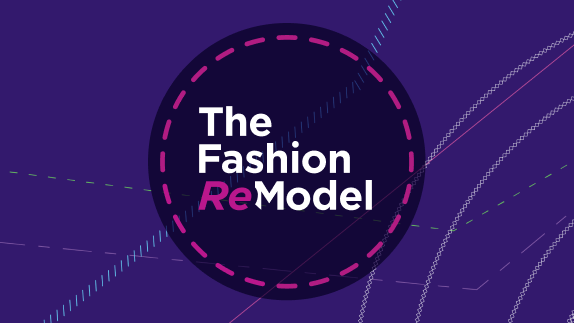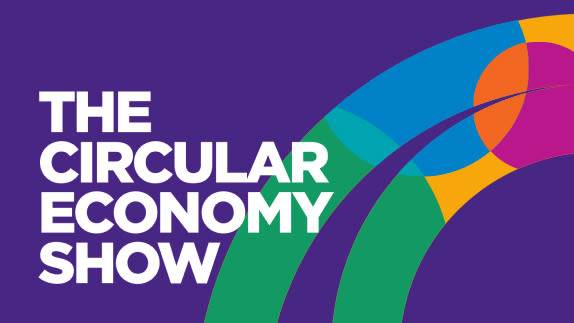In this episode of the Circular Economy Show, we explore the intersection between fashion, business, and technology - revealing why shoes are central to systemic innovation.
Live from the Ellen MacArthur Foundation Network event in Amsterdam, Kenny Arnold is joined by Dr Yuly Fuentes-Medel and Lewis Campbell from The Footwear Collective.
Together, they unpack the urgent need for innovation and collaboration in the footwear industry.
You’ll learn:
What The Footwear Collective is doing to tackle industry roadblocks head-on
How success is measured by unprecedented collaboration, robust data collection, and active participation from rival companies
Why their new tool will help companies pinpoint their next steps in their circular economy journey
Explore The Footwear Collective’s Circular Pathways tool https://thefootwearcollective.earthdna.org/
If you enjoyed this episode, please leave us a review or a comment on Spotify or YouTube. Your support helps us to spread the word about the circular economy.
Listen on Spotify, Apple Podcasts, or wherever you get your podcast.
Transcript
[00:00:00.04] - Fin Phillips
Shoes are essential items in our wardrobes. They allow us to walk, run and move. In this special episode of the Circular Economy show, we'll find out why there is a real need for innovation and collaboration in the footwear industry. I'm Fin and in today's episode, we're showing an exclusive session from the Ellen MacArthur Foundation Network event which took place in Amsterdam earlier this year. My colleague Kenny Arnold was joined by Dr. Yuly Fuentes Medel and Lewis Campbell from The Footwear Collective, part of EarthDNA. They work with a cohort of household names in the footwear industry to address common challenges through systemic innovation. You'll hear why we need to change the way shoes are made, why it's essential to work together, and how they plan to achieve this. Yuly started by explaining how the journey began.
[00:00:50.03] - Dr. Yuly Fuentes Medel
So I have worked in the intersection of fashion, business and technology for about a decade now, and I still hold the role of being the program director for MIT and climate. And I always been fascinated by the idea that fashion industry is core to the identity of us humans. So I was asked by the Institute to create an initiative that will really go and recreate what is going to be the integration of MIT for the fashion industry. Considering that in the 1920s, the institute did the first look at the fibre under the microscope. What could be 2022 in the time that it was, it was right, the pandemic time, but something happened in there. I don't know who was drinking what. And the footwear industry came back to the industry and said, listen, we've been working and talking a lot about apparel and the t-shirts and the clothing, which is really important work that we need to continue doing. But what about us, the shoes? I still don't consider myself an expert in shoes. People who make shoes and experts in shoes to really help and go and rediscover the conversation about what could be a system integration.
[00:01:58.05] - Dr. Yuly Fuentes Medel
Now think a product that you will always consider last because it's more complex, but also is a system in itself. So we invited companies, we invited, I think 25 companies came in. We have investors, we have waste managers, we invited the ecosystem to really tackle the question really privately, okay, let's talk about shoes. And since then, I think it's been the moment Air DNA was in the room supporting the project from MIT, we created a report that was going to be the end of my work in shoes. It's called the Footwear Manifesto. You can find it now online in Internet to really think about the challenges and opportunities for shoes. But the industry came back and said, listen, now we got the manual, but we need to go into action and do how. How do we do this?
[00:02:47.09] - Kenny Arnold
Great. And so how could we talk a little bit more about how Earth DNA and the Footwear Collective are trying to unlock systems innovation? What's on the horizon for you guys?
[00:03:00.05] - Lewis Campbell
Yeah. So we launched in October 2023 and we currently have 11 companies in our cohort. And I think really, when it pertains to system innovation, we're trying to be a practice first organisation and we're really emphasising the action piece of it. So we're going out with these 11 companies and we're executing projects to prove out circular business models and to prove out some of and to overcome some of the roadblocks that we've previously seen. And thinking about kind of how do we measure success in that? I think when you have 11 companies that are quite competitive with one another, we see footwear as a quite competitive industry. Success is both measured in how we're able to navigate the complexity of the projects. In my role, collecting the data, for example, that's a big ask, that's a big overhaul. But seeing how eager the companies are nowadays versus when we started in 2023 to actually submit data and ask us questions about what data do you think we need to solve this issue? What data do you think we can go internally in our own companies and champion for to actually come across and overcome some of these roadblocks.
[00:04:12.00] - Lewis Campbell
Additionally, with these companies, it's still a question of they show up every day. I think similar to seeing the participation in this event today and seeing the participation at the EMF Keystones, a big measure of success in these cross industry and these cross company initiatives is the willingness to participate. It's something that's extracurricular at times to your job. So seeing us being able to have weekly meetings, us being able to have monthly meetings and even biannual meetings and see our cohort and our members continue to come out and continue to champion ourselves is something that we don't take lightly and we consider a success metric ourselves.
[00:04:51.06] - Kenny Arnold
And so what kind of projects is underneath the Footwear Collective? As you spoke about the data that you're collecting, but can you tell us about some of those projects?
[00:05:01.02] - Dr. Yuly Fuentes Medel
So to create a project with shoes require people to go really deep in three aspects. One is the emotional connection you have to this product. We love shoes, but I think us was thinking, how do we elevate footwear into the essential form, which is shoes are our essential form of transportation. They are our tires. They allow us to walk, run and move as a human species. So if we don't think about them with that respect, we cannot really start implementing a system innovation thinking to put projects out that are going to look really isolated. Because when you present a project, it really doesn't have context. You have to be really quick, here's what we're going to do. This is how much it's going to cost and this is how much you're going to get returned. But you really need to present it in a system. So in itself, it's a system that allows you to really think systemically. The second thing is that I think in the algorithm, people who know how to make shoes I respect deeply. Now I just came back from a trip from Asia in how do we really make shoes?
[00:06:12.00] - Dr. Yuly Fuentes Medel
The people who is making these products really know their craft. And if they are able to in six months to create a collection and engineer a shoe, we can empower them to really reverse engineer that system. And the third component is we are building 23 billion pairs of shoes a year and guess where those shoes are after we use them. And just think back in time in terms of how much material companies are really throwing away. They're either in your closet or they are in landfills. Clogging systems for the waste system in municipalities and cities. So it's an item that everyone can participate in. It's a system that can be reverse engineered. And it's also that present projects that are tactical to really start putting out. How do you really go about solving for an industry that is also interactive with many other industries?
[00:07:15.03] - Kenny Arnold
Yeah.
[00:07:16.02] - Lewis Campbell
More tactically, in the footwear collective, how we organise and run those projects is that we have three primary pillars very familiar to all the circularity folks in the room that we run parallel. One being circular materials, thinking about the composition of the parts that we're seeing. Another being infrastructure filling the gap. I mean, after point of sale, a lot of our companies don't know what happens to the shoe. And and so we take that upon ourselves to do the work to collect post consumer waste, for example, and build infrastructure to collect that information. And finally, and arguably the most important part, consumer behaviour, it's understanding the behaviour and understanding the behavioural economics that gets people to participate in circular economy.
[00:08:00.01] - Kenny Arnold
And so you spoke about, I think 11 or so organizations that are part of the footwear collective. And can you share any samples or details of how you're working with them?
[00:08:10.01] - Dr. Yuly Fuentes Medel
We work with departments of marketing, innovation, materials compliance. The CEO, the CFO, he's really important and she's really important too, across the company in the pillars that we decide to do with data being across and business case being across. So that's a simple way to explain this. Each table we had a year really hands on work. Nobody knew we were working. The beginning of this was that a company say, okay, let's put money to really see if this system works. Nobody needs to know if fail or not. But if we fail, let's tell why we fail. We're really big about failure. And let's tell the story of how do we really build a system that can be used in any other industry in the future. And if a project doesn't have the potential to scale up, we say let's focus next in that one because we really this year need to prove and demonstrate that we have core for action. I think the other part of this is the projects that are happening in the infrastructure space. Things that the foundation has done beautifully in understanding the flows of materials in the waste systems. Who is going to take that, take back in a way that we can have a global system.
[00:09:28.08] - Dr. Yuly Fuentes Medel
So I think that's also the other explanation of how we work with the companies. Enabling the person for marketing to think about the consumer behavior and how he or she is going to interact. Enabling the person in material to think, okay, I do have a role in really participating in this equation because the moment I'm deciding what material put in my product, I do have a little bit of power to say this is going to be more circular or less circular. So that will be, I don't know if you want to add something else.
[00:09:58.04] - Lewis Campbell
Yeah, just a little tidbit and I think building off what you said, thinking about the human in order to execute these projects and our approaches to this system innovation is yes, the outward facing projects that we're working on in each of the pillars. But I think to Yuly's point, we also look internally a lot and we ask ourselves how do we empower the experts, the folks who are doing this work? And part of my job is thinking about what are the toolkits and what are the internal systems that we can build to make sure that the people in marketing feel included in circular economy, that the people in procurement and product development also understand what their role is and how they can participate.
[00:10:40.03] - Fin Phillips
To help with this, the Footwear Collective introduced a circular pathways tool which allows different teams to identify the ways they can take action at a pre competitive stage.
[00:10:50.03] - Lewis Campbell
The TFC Pathways tool we're really understanding, it was an exercise in understanding where are our companies coming from we have companies who have tried and failed and tried again. We've had companies who joined the Footwear Collective with no circular expertise whatsoever, building their circular strategy and very eager to build their circular strategy. So the question is, how do we merge these two levels of expertise into something that's really conducive for the space? So the Pathways tool is an exercise to kind of to think of circular economy for footwear as almost a plug and play activity where we understand this work has to run in parallel to one another. It can't run in sequence. We can't, we can't risk the delay and the duplicate of efforts of running something in sequence and running something in isolation. So we came up with the Pathways tool as a tool to identify where do you want to work and also as a cue to what's next. So that's where the now next feature comes into play. So if there's an idea of where you want to work, you can click into that idea and you can also see a kind of sequence of what happens after we accomplish this initial action.
[00:12:09.08] - Lewis Campbell
And it's a living document. It's not perfect. We're all about imperfect action. It's something that we hope continues to grow and that we're taking active feedback on because we understand we have a network of 11 companies, but that's nowhere near representative to the whole shoe problem.
[00:12:27.07] - Fin Phillips
With the floor open for questions, one audience member asked whether the Footwear Collective would share tools to allow the wider industry to understand the current state of circular efforts and perhaps help new companies identify areas where they can contribute or benefit.
[00:12:42.08] - Dr. Yuly Fuentes Medel
So the brief answer is that when we started, the companies came back with 50 projects and I was like, I love you teams, but there's no way you're going to execute 50 projects in one year. So we needed to kind of create a prioritisation tool that will allow us to say, what is the long hanging fruit and the long term gain here for the industry that led to the creation of the tools where now we know a project in material, a project in infrastructure, and a project consumer behaviour. So we're going to be sharing and using the tool to really showcase the projects and really invite the other companies to really be part of the collective. So the real example is that when you create a collective tool now, you don't need to be doing all the projects because your companies don't have the budget to do so. That's the other aspect of unlocking financially, what can you do in where you are expert and how can you help your industry? And your peers to really activate the next level.
[00:13:42.08] - Kenny Arnold
And so that the information on that tool, the output is open.
[00:13:46.09] - Lewis Campbell
It will be public and we encourage you to take a look and see where you want to play.
[00:13:53.01] - Fin Phillips
Another audience member asked Yuly and Lewis if they had new ideas for a new collective with a new product, which products would they be interested in looking at?
[00:14:01.07] - Dr. Yuly Fuentes Medel
I think one of the things when I was in the room in March 7, 2022 and the footwear industry started opening their secrets because it was a really meaningful meeting for me personally shifting my career to shoes. Now we talk about the special of the footwear as an item, but it's an item that has parts, it has many materials and it's complex. So I think what we are inventing for the shoe can be used in other consumer products. The person doesn't buy only the shoe. You need to think about their purchase behaviour. So eyeglasses, coffee makers, anything that will also understand how do you really target materiality, how do you go about infrastructure system and what is the consumer sentiment that you want to build in this process. So yeah, my favourite is eyeglasses because it will be easier, but we didn't start there. What is your favourite?
[00:15:02.05] - Lewis Campbell
I'm stubborn, I love shoes, I'm never going to leave.
[00:15:08.05] - Kenny Arnold
Fair enough. Yeah.
[00:15:10.07] - Fin Phillips
So we heard how the Footwear Collective is focusing on circular materials, infrastructure and pre competitive collaboration. To explore the Pathways tool mentioned in this episode, follow the link in the show notes. Thanks for listening to this episode of the Circular Economy Show. As always, please leave a like or a comment and remember to subscribe wherever you get your podcasts. See you next time.




